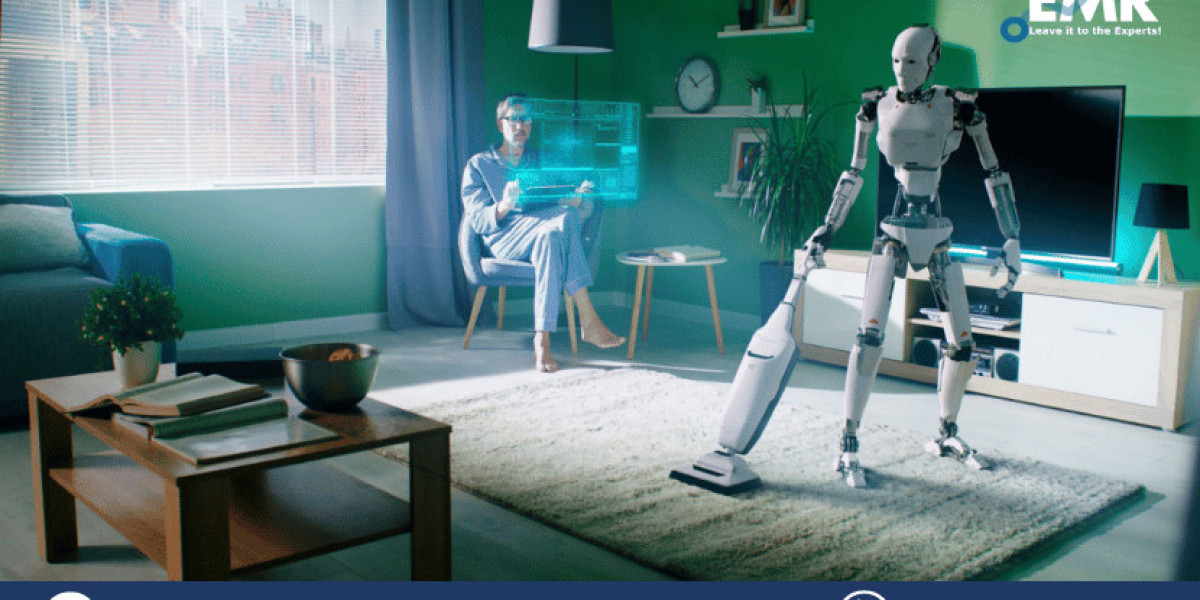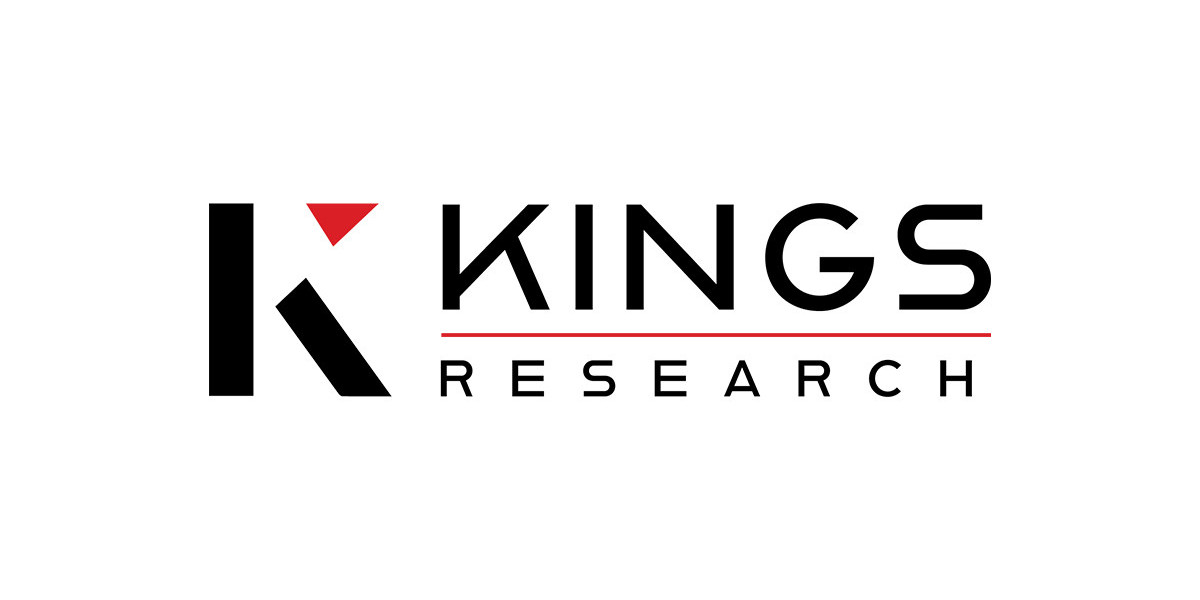Household Robots Market Introduction
The global household robots market stood at a value of nearly USD 5.45 billion in 2023. The industry is further expected to grow at a CAGR of 22% over the forecast period of 2024-2032. These staggering figures underscore the rapid evolution and adoption of household robots in our daily lives. At the heart of this transformation lies artificial intelligence (AI), which is propelling household robots to new heights of functionality and usefulness.
In this blog post, we will embark on a journey to explore the remarkable impact of AI in shaping the future of household robots. We'll delve into the current landscape of household robots, the integration of AI into these machines, key AI technologies powering them, the enhanced capabilities they offer, and the exciting developments on the horizon. However, we won't shy away from discussing the challenges and ethical considerations that come hand in hand with this AI-driven revolution.
So, fasten your seatbelts as we navigate through the world of household robots infused with artificial intelligence, and discover what the future has in store for us.
The Current Landscape of Household Robots
To appreciate the significance of AI in household robots, it's crucial to understand the current state of these machines. Household robots have come a long way from being simple, single-purpose devices to multifunctional assistants capable of performing various tasks.
In recent years, the market has witnessed the emergence of several notable household robots:
Robotic Vacuum Cleaners: Devices like the Roomba have become household names, autonomously cleaning floors using sensors and algorithms.
Robotic Lawn Mowers: These robots are designed to keep your lawn perfectly manicured without any manual effort.
Smart Home Hubs: Devices like Amazon Echo and Google Home incorporate AI to control various smart home devices, offering voice-activated assistance.
Personal Assistant Robots: AI-powered robots like Jibo and Pepper can recognize faces, engage in conversations, and perform tasks like reading stories to children.
These are just a few examples of the diverse range of household robots available today. However, what makes them truly remarkable is the infusion of AI technology, which takes their functionality to a whole new level.
The Integration of AI in Household Robots
Artificial intelligence is the driving force behind the evolution of household robots. AI enables these robots to perceive their environment, make decisions, learn from interactions, and adapt to users' needs. Here's how AI is being seamlessly integrated into household robots:
Natural Language Processing (NLP): NLP allows robots to understand and respond to voice commands and engage in natural conversations with users. This capability enhances the user experience, making human-robot interaction more intuitive.
Computer Vision: AI-powered cameras and sensors enable robots to "see" and navigate their surroundings. They can detect obstacles, avoid collisions, and even recognize specific objects or people.
Machine Learning: Machine learning algorithms enable robots to improve their performance over time. They can learn user preferences, adapt to changing environments, and optimize their tasks.
Speech Recognition: Advanced speech recognition technology allows robots to understand spoken commands accurately. Users can communicate with their robots effectively, making them more accessible and user-friendly.
These AI technologies serve as the foundation for household robots' enhanced capabilities, making them indispensable in various aspects of daily life.
Get a Free Sample Report with Table of Contents@ https://www.expertmarketresearch.com/reports/household-robots-market/requestsample
Key AI Technologies in Household Robots
Let's take a closer look at the key AI technologies that power household robots and understand how each of them contributes to the robot's functionality:
Natural Language Processing (NLP): NLP is the technology that enables robots to understand and generate human language. This means that you can communicate with your household robot using voice commands or text input, just like you would with a human assistant.
Computer Vision: Computer vision allows robots to "see" and interpret the world around them. They use cameras and sensors to recognize objects, people, and obstacles, enabling them to navigate your home, avoid collisions, and perform tasks more efficiently.
Machine Learning: Machine learning algorithms empower robots to learn from their experiences and improve their performance over time. This means that your robot can become better at understanding your preferences, optimizing its tasks, and adapting to changes in your environment.
Speech Recognition: Speech recognition technology enables robots to understand and process spoken language. Whether you're asking your robot to play your favorite song or give you a weather update, speech recognition makes it possible for the robot to understand and respond to your requests accurately.
Enhanced Capabilities
Thanks to AI, household robots are no longer limited to basic tasks. They now offer enhanced capabilities that make them incredibly versatile and valuable additions to your home. Here are some ways in which AI-powered household robots have improved their functionality:
1. Improved Navigation and Obstacle Avoidance: AI enables robots to navigate your home with remarkable precision. They can create maps of your living space, avoid obstacles in real-time, and even find the most efficient routes to complete tasks. This means fewer collisions and more efficient cleaning or other tasks.
2. Customized User Experiences Through Learning Algorithms: AI-powered household robots can learn from your interactions and adapt to your preferences. For example, a robot vacuum cleaner can learn which areas of your home require more frequent cleaning and adjust its schedule accordingly. Over time, these robots become more attuned to your needs, making your life easier and more convenient.
3. Better Understanding and Response to User Commands: With AI, household robots can understand and interpret your commands more accurately. Whether you're asking your robot to set a timer, answer a trivia question, or control other smart devices in your home, AI ensures that your robot comprehends your requests and executes them effectively.
4. Enhanced Monitoring and Security: AI-powered security robots can provide enhanced monitoring of your home, sending alerts and notifications if they detect unusual activities. They can also learn to differentiate between normal events, such as your pet moving around, and potentially concerning situations, increasing the overall security of your home.
5. Personalized Recommendations and Assistance: Some AI-powered household robots can provide personalized recommendations based on your preferences. For example, a robot that helps with meal planning can suggest recipes based on your dietary restrictions and food preferences. These robots can also assist with scheduling and organization, making your daily life more efficient.
Future Developments in Household Robots
The future of household robots is incredibly promising, with AI playing a central role in their continued evolution. Here are some exciting developments we can expect to see in the world of AI-driven household robots:
1. Personalized Robot Assistants: In the near future, we can anticipate the emergence of highly personalized robot assistants. These robots will be capable of understanding and catering to individual preferences, making them even more valuable in daily life. Whether it's helping with cooking, organizing tasks, or providing companionship, these robots will adapt to your specific needs.
2. Integration with Smart Home Ecosystems: Household robots will become increasingly integrated with smart home ecosystems. They will seamlessly work alongside other smart devices, such as thermostats, lights, and security systems, to create a fully automated and interconnected home environment.
3. Enhanced Security Features: Security-focused robots will become more sophisticated, offering advanced monitoring and surveillance capabilities. These robots will be equipped with AI-powered facial recognition, intruder detection, and real-time alerts, further enhancing home security.
4. Improved Human-Robot Interaction: As AI continues to advance, we can expect more natural and intuitive interactions with household robots. They will become better at understanding context, recognizing emotions, and responding empathetically to human needs.
5. Expanding Applications: The applications of household robots will continue to expand. From healthcare and childcare assistance to entertainment and education, these robots will find new ways to enhance our lives and make tasks more manageable.
Challenges and Considerations
While the integration of AI into household robots holds tremendous promise, it also raises important challenges and ethical considerations that need to be addressed:
1. Privacy Concerns: As household robots become more capable, they may collect and store personal data, raising concerns about privacy. It's crucial to establish robust privacy safeguards and regulations to protect users' information.
2. Dependence on Technology: Increasing reliance on AI-driven robots could potentially lead to a sense of dependence on technology. Striking a balance between automation and human involvement in daily tasks will be essential.
3. Ethical AI Usage: Ensuring that AI algorithms in household robots are developed and used ethically is of paramount importance. Bias in AI and ethical dilemmas in decision-making processes should be carefully addressed.
4. Security Risks: Like any connected device, household robots may be vulnerable to cybersecurity threats. Protecting these robots from hacking and unauthorized access is crucial to prevent potential risks.
Media Contact:
Company Name: Claight Corporation
Contact Person: Louis Wane, Corporate Sales Specialist – U.S.A.
Email: sales@expertmarketresearch.com
Toll Free Number: +1-415-325-5166 | +44-702-402-5790
Address: 30 North Gould Street, Sheridan, WY 82801, USA
Website: https://www.expertmarketresearch.com








